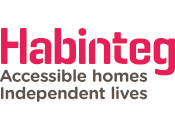
Adapting your home: the kitchen
Adapting your home: the kitchen
This factsheet is available for sponsorship, email marketing@dlf.org.uk
Sponsorship has no influence on our impartial content
Factsheet contents
- Introduction
- Meeting the needs of an individual
- Designing an accessible kitchen
- General design considerations
- Design considerations for multiple users and abilities
- Design considerations for those with cognitive issues
- Design considerations for people with a visual impairment
- Design considerations for wheelchair users
- Kitchen adaptations for children
- Funding kitchen adaptations
- Further advice from us
- Contributors
- Useful organisations and resources
- References and further reading
Introduction
A kitchen adaptation can be one of the most expensive areas within your home. When planning any changes to the kitchen area, it is worth thinking about the following:
- How do I currently use the kitchen? What aspects of the kitchen are difficult for me to use?
- Who else uses the kitchen? Am I planning to entertain and socialise in the kitchen area?
- Would I like to be able to prepare and cook meals from scratch or would I prefer to heat up ready-made meals in a microwave?
- Are there other tasks I need to do in the kitchen? For example, doing the ironing, feeding the dog, or putting the washing on?
- Do I need to limit access to the kitchen or facilities (e.g. gas oven or hob) for safety?
- What do I want to do in the kitchen in the future?
- Do I have any family members who may need to learn kitchen skills for future independence?
Meeting the needs of the individual
There are a variety of conditions that can impact on your ability to use the kitchen. Consider the following:
- How is my hand strength and movement? How strong is my grip?
- How is my mobility and how long can I stand unaided for? Do I need to sit down to prepare meals? Do I use a walking frame or wheelchair?
- Do I have any vision or hearing problems?
- Do I have difficulty remembering where essential items are stored?
- Am I able to reach up, down or across my body?
- Do I have the strength to lift a saucepan or kettle, etc? Do I have difficulty carrying hot drinks and meals to a table or another room?
- Can I access my kitchen safely and easily? Or are there steps into the kitchen?
- Is my condition likely to change or deteriorate?
- Are changes needed to help someone learn kitchen skills for future independence?
The risks of injury are far greater for those with physical, visual and cognitive impairments but it is important to balance the risk of injury against the rights of the person to make their own choices and decisions about what they chose to do and how they their operate in their home. It is important where possible and safe to do so, to support and promote a person's independence and personal choices.
If you need to control or restrict someone’s use of the kitchen because of safety concerns - for example, in the case of young children or for people with additional needs such as autism or dementia who may be less aware of potential risks, more information can be found in DLF's fact sheet Adapting your home: managing cognitive impairment and challenging behaviour.
Small changes
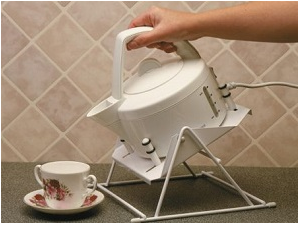 Before embarking on the costly process of designing a new kitchen, it may be worth considering what small changes you can make to improve access and usage. For example:
Before embarking on the costly process of designing a new kitchen, it may be worth considering what small changes you can make to improve access and usage. For example:
Difficulty lifting kettles and saucepans
A smaller kettle can be easier to lift. A kettle tipper holds the kettle or teapot and provides support when tilting and pouring out the contents. Alternatively a hot water drink dispenser removes the need to lift a kettle or carry hot water. Consider replacing heavy pots and pans with lighter weight versions. Using a cooking basket for vegetables enables you to lift the basket out of the pan, rather than having to lift the whole pan.
Cupboards that are out of reach
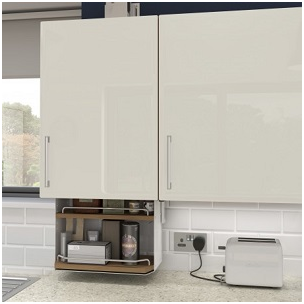
- Re-organise the kitchen so that things you use the most are easily accessible. Use one or two cupboards or shelves for the items you use on a daily basis and store away the other lesser-used items in harder to reach cupboards and shelves.
- If your existing wall cupboards are too high, consider adding a shelf below the cupboards, or hooks so that items that you use every day, such as mugs and tea, coffee and condiments are within easier reach
- Consider installing pull-down baskets in wall cupboards, and/or pull-out shelving, drawers or carousels in cupboards. These can bring kitchen items within a more comfortable reach and can limit the need to bend
- Consider switching to a table top oven or fridge to limit bending.
Difficulty standing
If you have limited standing balance or need to rest frequently, a perching stool can be of benefit.
Difficulty with gripping and turning
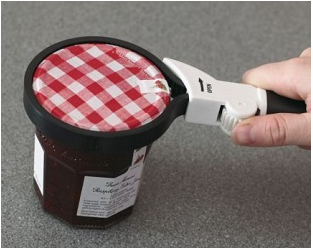 If you have difficulty turning taps on or off you may wish to consider purchasing lever taps.
If you have difficulty turning taps on or off you may wish to consider purchasing lever taps.
Tin openers that have a larger grip or contoured handles may improve ease of use.
There are also a range of jar openers with features such as improved grip or automatic powered operation. D shaped handles on kitchen cupboards and draw handles can be easier to grip.
Food preparation using one hand
 There are a number of devices that you can use to make it easier to prepare food with one hand. For example:
There are a number of devices that you can use to make it easier to prepare food with one hand. For example:
- Work stations and boards to help stabilise vegetables for peeling or to position a slice of bread for spreading
- Non-slip mats to reduce the risk of dishes/plates moving around.
There are also many kitchen aids available to help with a variety of difficulties from food preparation to eating and drinking.
An Occupational Therapist or your local Social Services maybe able to trial aids and gadgets with you to make life easier. Alternatively you can get advice privately from an Occupational Therapist who can assess your difficulties and recommended aids and possible changes you could make at home.
Designing an accessible kitchen
The design of a new kitchen will vary enormously, depending on the size and layout of the existing kitchen and the needs of the users and their difficulties. It is advisable to consult an Occupational Therapist so that they can carry out a full functional assessment to ensure that the kitchen is designed to meet your specific needs and priorities.
The key principles
A key design principle is to consider whether you can create a ‘working triangle’ The general advice is that kitchen layouts should be planned so that the oven, hob and sink unit are in a continuous uninterrupted run of units. The run of units may be straight, L-shaped or U-shaped. This working triangle approach is recommended to create a flow between the appliances, minimising the amount of movement required in between the food preparation, cooking and cleaning/washing up tasks, thus conserving energy and time for everyone who uses it. If the distance between these main work areas is too small, people may feel cramped or if the distance is too large, more energy will be consumed walking, wheeling, lifting, carrying and cleaning etc.
If possible, it is recommended to always design for your worst possible day or the worst possible future in order to try to ‘future proof’ the environment.
General design considerations
Space requirements
Space requirements may vary according to whether you need to use a wheelchair. Detailed guidance on minimum dimensions are laid out in the Approved Document M (4) Category 3b Wheelchair Accessible and additional best practice guidance can be found in The Wheelchair Housing Design Guide.
Kitchens should have a minimum clear width of 1200mm between kitchen unit and appliance fronts and any fixed obstruction opposite (such as other kitchen fittings or walls). Wheelchair users require an uninterrupted floor space for the wheelchair turning circle of 1500mm. However this may vary depending on the wheelchair size. A person walking, but with mobility issues, may prefer a more compact space.
Storage
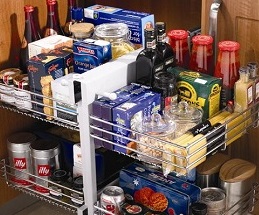 Carousels, pull out drawers and work surfaces, wheeled work surfaces and pull-down baskets can all be useful, depending on a person's strength and movement limitations.
Carousels, pull out drawers and work surfaces, wheeled work surfaces and pull-down baskets can all be useful, depending on a person's strength and movement limitations.
The depth of the work surface should be 600mm. To enable an easy reach of any wall hung cupboards, units should be positioned a maximum of 300mm above the counter top.
Sinks and taps
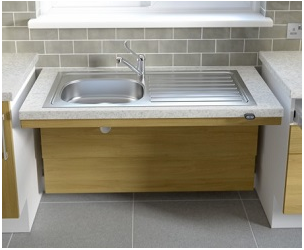 In a family kitchen height adjustable sink units with flexible plumbing will provide more options for ease of use for people of different heights and abilities. A sink with a shallow insulated bowl that provides knee space underneath can allow wheelchair users to reach it more easily.
In a family kitchen height adjustable sink units with flexible plumbing will provide more options for ease of use for people of different heights and abilities. A sink with a shallow insulated bowl that provides knee space underneath can allow wheelchair users to reach it more easily.
Most lever taps only require a quarter turn to turn the tap fully on and off and can be beneficial for people with limited dexterity of grip strength. Taps with hose attachments or high loop swivel taps can make it easier to fill a kettle for example. Taps that are easier to recognise and operate and have clear hot and cold water indicators can be considered for people with dementia who may find modern lever taps confusing. The water pipes supply could also have a thermostatic control installed to reduce the risk of scalding.
Large D handles on cupboards and drawers which are easy to grip or place fingers through may be beneficial for those with difficulty gripping. Recessed/profiled drawers and cupboards with light touch opening can be easier to open and remove protrusions that may be an issue for people who bruise easily
Kitchen appliances
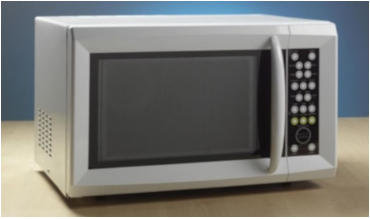 Careful consideration should be made when purchasing any new appliances.
Careful consideration should be made when purchasing any new appliances.
- Look at how the doors to fridges, washing machines and dryers open. Will they hinder access and/or make it more difficult to reach and use them? Can the washing machine and dryer doors be opened to allow for any washing to be taken out and moved directly from one appliance to the other? Can the table top fridge door be re-hung so that items can be slipped onto the work surface without having to carry them?
- Kettles and other kitchen aids should contrast in colour or tone with the counter top so they are easily identifiable.
- Look at the dials/knobs on appliances. How easy are they to turn and adjust? Is the writing on dials easy to see? Do the knobs click or have raised bumps? Are they easy to grip and turn if your hand movement and strength is affected?
- Consider talking microwaves and oven timers if you have visual difficulties.
- Ovens should have a side opening door with a telescopic slide out, non tip shelves and a heat resistant pull out shelf to enable dishes to be slid out of the oven and directly onto the work surface. If the door is pull down it should slide away into the base of the oven. The door should open at 180 degrees
- Placing white goods on a 200mm plinth can make them more accessible to wheelchair users
- Ensure there are no trailing wires on the floor or work surfaces.
Further advice on choosing appliances can be found on RiDC's website.
Cookers and hobs

- The oven should be placed, where possible, in a housing which has a variable height shelf. The oven should have a side opening or have a drop-down retractable door, with non-tilt shelves. There should be a heat resistant pull-out surface below the oven and the door should open towards an adjacent worktop level (minimum width 400mm). The controls should be no higher than 1000mm from floor level
- The recommended height for an extractor unit is normally 600mm above the hob for electric and 700mm for gas. Where the hob or wall units are adjustable, the height of the extractor should also be variable. Where a wheelchair user may not be able to reach the extractor controls, a heat activation should be considered (Foundations)
- To help make it easier to transfer heavy hot pots and pans, the hob should be level with the work surface, with controls located at the side or front.
Further reading: Choosing cookers, ovens, hobs and microwaves by RiDC.
Operating switches and controls
Sockets and electrical points should be 100mm–150mm above the work surface and at the side of the wall where possible so they are easy to access. Rocker switches may be helpful for those with difficulty gripping and/or pushing small objects. A double socket with the switches placed on the outside, rather than centrally, can help make it easier to use.
Flooring
Slip resistant flooring is recommended, so as to minimise the risk of falls. Guidance is available from the Health and Safety Executive. If the kitchen dining area is open plan, avoid a stark difference in colour or tone between the kitchen and dining areas. A dark floor next to a light floor for example can be perceived as a hole or a step for some people with dementia.
Windows
Windows should be within easy reach. Fitting window openers can help with opening and closing windows. These can be manually or electronically operated.
Lighting
- Consider the positioning of the light sources. Avoid placing light sources behind the user, as it can cast a shadow onto the work surface
- Task lighting (lighting that is directed onto worktop, sink, hob etc) can help make it safer to carry out key tasks where there may be higher risks - for example chopping food, cutting bread, pouring hot liquids
- In key task areas lighting should draw attention to and prompt every day activities. Lights with a dimmer switch can offer flexibility to respond to individual needs and create mood lighting
- Lighting inside drawers and cupboards can help make it easier to find items
- Maximise on natural light where possible - diffused lights, spotlights and under counter lights may also be helpful. A good visual contrast between different surfaces will help those with vision loss.
Design considerations for multiple users and abilities
The key in designing a kitchen for multiple users is simplicity and flexibility; it will largely be dependent on the abilities each user has and will require careful assessment and consideration to ensure one design element does not negatively impact on another.
Worktops
Fixed worktop heights should be at 760mm for a wheelchair user, 900mm for a walking (ambulant) user or 850mm for use by both. For wheelchair users a continuous worktop that incorporates a hob and sink with minimum clearance of 700mm below the worktop for knee space is required for easier access. There should be a toe recess 250mm by 150mm at the bottom of the base units to enable a person to sit as close to the work surface as possible
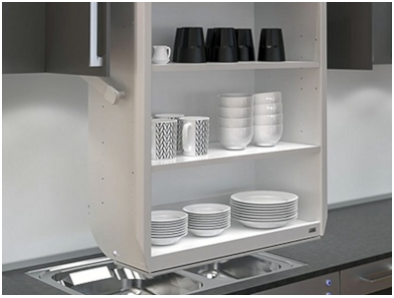 Height adjustable units, or rise and fall units, can be operated automatically or manually by either a switch or a winder. The units can be raised and lowered to the desired height of the person using it at the time, thus helping to ensure strain is not put on the user's back by having to prepare food on a low work surface or prevent them from using the unit altogether
Height adjustable units, or rise and fall units, can be operated automatically or manually by either a switch or a winder. The units can be raised and lowered to the desired height of the person using it at the time, thus helping to ensure strain is not put on the user's back by having to prepare food on a low work surface or prevent them from using the unit altogether
The depth of the work surface should be a minimum 600mm - this allows for comfortable reach. However if reach is not an issue, a deeper worktop can accommodate worktop level storage. The work surface should be continuous at the same height to enable items to be pushed or pulled along the counter to reduce the need to lift and carry. If space is limited to provide worktops with knee space, a pull-out worktop may be an option.
If the kitchen and dining area is open plan, consider whether there is an option to extend the worktop, or position it as close as possible to the dining area, to avoid the need to lift or carry meals or hot drinks.
Good visual contrasts between work surfaces, appliances and electrical sockets will help those with visual and memory problems.
Any exposed hot water pipes should be insulated to protect from burning, especially if the person is sitting with their knees under the counter.
Design considerations for those with cognitive issues
It is important to consult an occupational therapist who is experienced in assessment for people with cognitive impairments.
A comprehensive assessment can help to understand the person's needs, what it is they wish to do and what they are able to do safely. It will also ensure that any alterations to the kitchen area will not hinder or put the person at risk.
This is a broad title for very varied and complex impairments; we do not cover all the different types of cognitive issues here (which can include someone who has special learning needs, dementia, a brain injury, conditions relating to general aging, a neurological illness or a congenital disorder). These examples can all cause difficulties - for example with sequencing (the ability to arrange language, thoughts, information and actions in an effective order) not being able to understand danger, or being unable to recognise everyday objects.
If you are refurbishing a kitchen for a person with cognitive problems, such as dementia, then a simple uncluttered design layout that resembles what the person is familiar with is recommended (Government of South Australia, 2008). Also a good visual contrast between adjacent surfaces, e.g. walls and worktops and fittings, e.g. electrical switches and sockets, will help by drawing attention to essential features. (BS 9266:2013 Design of accessible and adaptable general needs housing – Code of Practice).
In some situations it may be necessary to prevent access to all potentially dangerous areas, such as the hob or oven, to reduce the risk of burns or scalds. In these circumstances you may need to contact your energy supplier to request turning off or capping gas supplies.
Reducing risk and enabling independence
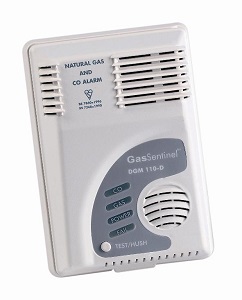 There are some simple changes you can make to reduce potential risks whilst at the same time enabling people to continue to be independent with simple tasks in the kitchen. These include:
There are some simple changes you can make to reduce potential risks whilst at the same time enabling people to continue to be independent with simple tasks in the kitchen. These include:
- Minimising clutter on the floor and work tops
- Minimising large areas of reflective surfaces that can cause confusing reflections and glare
- Provide task lighting that falls onto the worktop and does not cause the user to create shadows
- Store key items on open shelves or cupboards with see through doors that are within comfortable reach
- Adding safety locks on cabinets and pantry doors may be useful to limit access to certain kitchen utensils, food types or hazardous substances if there is a risk these may be misused. Drawer and fridge locks are also available
- Label drawers, cupboards and fridges to indicate the contents. Consider using picture stickers
- Select taps that indicate hot and cold and are traditional in appearance and designed to be easy to use. Consider high loop taps that can be swivelled over onto the drainer to make it easier to fill a pan or kettle
- Consider fitting an isolator switch that can be programmed to switch off the cooker and hob. Also fit stove (also referred to as burner) covers and stove knob covers. Stove covers “hide” the cooking elements and may discourage stove usage
- Select kettles and toasters that are traditional in appearance and simple and intuitive to use. Remove hob kettles that might be left on and forgotten
- Consider the need for heat, smoke and carbon monoxide sensors and alarms. Most of these sensors can be linked to Telecare systems to alert carers.
- Fitting safety gates or stable doors to help to control access.
Further reading: DLF's fact sheet Living with dementia: food preparation
Design considerations for people with a visual impairment
There are many different and varying types of visual impairment and vision loss. Some key design ideas are covered here.
Your local social services department may be able to offer you a sensory services assessment in which they can offer you advice and aids to help in the kitchen. If you need to make changes to your kitchen due to your eyesight, there may also be other vision related services or equipment that would be of benefit to you.
- A minor modification and/or change to a kitchen's layout and storage areas can have a major impact and can delay or remove the need to change the whole kitchen
- Aim for good, constant lighting. This can be achieved by straight fluorescent lamps or LED strip lights that provide even levels of light across the area and reduce the risk of shadows (Lighting in and around the home: A guide to better lighting for people with sight loss 2018). Making changes to the lighting in your kitchen and using colour and contrast to make items stand out can help them be more easily identifiable. Also see the section entitled Lighting above. Provide additional ‘task’ lighting over areas such as sink cooker and work areas. More information can be found in the section entitled Lighting above
- Avoid large surface areas of glossy, reflective finishes as they create glare and shadows. Aim for a low level of reflection
- Remove doors to cupboards or fit closures to drawers and cupboards to reduce the risk of bumping into doors that are left open
- Controls which are located on the front of hobs and cookers help prevent users from having to reach over a potential heat source when using the appliance.
Further information
Visit the AskSARA Kitchen and vision section, for guided advice about kitchen products related to vision.
Read RNIB's article on Cooking with sight loss by RNIB and Thomas Pocklington Trust's guide on Good practice in the design of homes and living spaces for people with dementia and sight loss.
Design considerations for wheelchair users
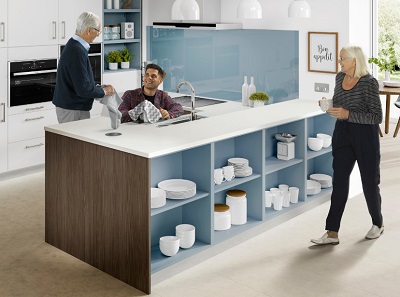 Sometimes it is essential to reassess the wheelchair style and fittings, for example the type of footplates, or type of control of a powered wheelchair in conjunction with the kitchen design. In some cases if there are particular space constraints for example, and it is an affordable option, a height adjustable wheelchair may be a way to make it easier to access storage.
Sometimes it is essential to reassess the wheelchair style and fittings, for example the type of footplates, or type of control of a powered wheelchair in conjunction with the kitchen design. In some cases if there are particular space constraints for example, and it is an affordable option, a height adjustable wheelchair may be a way to make it easier to access storage.
It is advisable to consult an occupational therapist who specialises in wheelchairs before considering making a purchase yourself. Alternatively, your GP, physiotherapist or hospital staff can refer you to your local wheelchair service for an assessment. The type of wheelchair that might be provided for you by the NHS will depend on an assessment of your specific individual needs.
Worktops
- The run of units may be straight, L- or U-shaped. This triangle approach is recommended to create a flow between the appliances, minimising the amount of movement required in between the food preparation, cooking and cleaning/washing up tasks
- The work surface should be continuous and at the same height. This can enable items to be pushed or pulled along the counter and reduce the need to lift and carry
- Counter tops should be no deeper than 600mm and should provide clear unimpeded leg space. There should be a minimum 400mm preparation area either side of the sink and oven and fridge
- If you are going to be pulling up to the worktop with your thighs positioned underneath, then it is essential to accurately measure the actual thigh height when seated and then allow approximately 20mm for comfort. 700-850mm high is the usual range (Thorpe, 2006).
Cupboards and units
- A carousel-type unit should be considered to enable access to difficult to reach corner base units
- Pull-down or adjustable wall cupboards can be considered for the wall cabinets. Pull-out drawers, work surfaces and larders and wheeled work surfaces may be helpful
- If storage space is lost under counter cupboards and drawers to facilitate the clear leg space then pull-out larders or alternative storage options will need to be explored.
Sinks and taps
- A shallow insulated sink bowl (150mm deep) will allow a wheelchair user to get much closer to the sink. Any hot water pipes should be insulated to protect the user's legs from burning. The water could also have a thermostatic control installed to reduce the risk of scalding. Position taps at the side of the bowl to aid ease of use
- A mixer tap with lever handle will enable an easier control of water flow and temperature. A swan neck high swivel arm tap with sufficient height and size will enable the filling of a pot or kettle whilst placed on the drainer or work surface (Wheelchair Design Guide 2018)
- Taps with hose attachments can also make it easier to fill kettles or pans without the need to lift
- Consider the option of locating the tap at the front of the fascia to make it easier to reach
Floorspace
- An uninterrupted floor space of 1500mm x 1500mm is required for a wheelchair turning circle of 1500mm. However this may vary depending on the wheelchair size.
Cooker and hob
- The oven should be side opening or have a drop-down retractable door, with non-tilt shelves and controls that are no higher than 1000mm from floor level
- The oven should be in a housing that allows for the central shelf to be level with the adjacent worktop
- There must be a minimum of 300mm worktop space to the side of the oven on the opening side of the oven door, with knee recess underneath
- The hob should be fitted with front controls to enable easier access. An induction hob is often considered the safest option as it reduces the risk of burns. Gas hobs are not recommended, they are considered less safe due to the open flames and the possibility of leaking gas
- An extractor hood will reduce the amount of steam generated at face level. Controls should be within easy reach.
White goods
- Freestanding white goods can sometimes be deeper than integrated units, which may cause an obstruction. Where possible integrated appliances with no or low profile edges are recommended
- A dishwasher may be helpful as it will reduce the time and energy spent washing up by hand.
Electrical sockets
- Electrical sockets should be positioned between 100mm – 150mm above work surface and where possible positioned on a side wall or on the front of the worktop, to make them easier to reach
- Where there are double sockets, switches located on the outside are easier to operate
Kitchen adaptations for children
There are two approaches to kitchen adaptations and these will depend on the child’s needs.
- If it is realistic that a child or young person will achieve independent living then it may be possible to adapt the kitchen using a Disabled Facilities Grant. Where a child or young person may be able to manage a limited range of kitchen activities it is unlikely a fully adapted kitchen will be needed
- The second approach is managing safety for those children who are at risk in the kitchen. Information in DLF's fact sheet, Adapting your home: managing cognitive impairment and challenging behaviour provides suggestions on either reducing risk and/or preventing access.
Funding kitchen adaptations
If you are paying privately it may be one of the largest investments you will make in your home, so its important that the final result suits both your needs and tastes. In some situations you may be able to receive assistance with modifications. You may wish to approach your local social services Occupational Therapy Team via your local council in the first instance to see if you can obtain an OT assessment. However please be advised that waiting lists and eligibility vary greatly from area to area.
If you are self funding, you may wish to seek advice from a specialist housing OT who can work with you to design the best possible kitchen to meet your individual needs.
Provision of equipment
There are a few options available for funding of equipment and minor adaptations; this can vary across the UK. We provide an overview of the options available here, but it is worthwhile checking what arrangements are in place locally.
In England, if you are assessed as requiring preventative intervention, equipment under £1000 would be free of charge to you (Department of Health 2014, section 2.9). In Scotland, Local Authorities make their own arrangements for provision of minor adaptations and details can be accessed via your Council website. If the equipment or adaptation costs more that £1000, you may have to apply for a Disabled Facility Grant (Mandelstam 2016).
The Money Advice Service has some useful information about funding for adaptations.
It is recommended that you seek advice from an occupational therapist before considering which equipment is suitable to you. You may be entitled to an assessment by a Local Authority Social Services Occupational Therapist. Alternatively a list of independent Occupational Therapists can be found on The Royal College of Occupational Therapists' website.
Private purchase
If you need advice before you buy, contact your local equipment demonstration centre where you would have the opportunity to try out a range of equipment. There are several of these around the country where you can go for impartial advice. Your local authority will also be able to supply information about where your nearest centre is located. Also Disabled Living Centres and some retailers have showrooms which have areas set up so you can try out items of equipment to see if they will suit you before you commit to making a purchase.
If you are unsure if you can afford the equipment or any of the associated costs, requesting an assessment or advice from an Occupational Therapist or local well-being service (local areas may have different titles for support services) will help with decision-making. It may be that another way of accessing equipment is more suitable for you.
Also consider if you can afford a service contract for more complex items of equipment. These may seem expensive at first but in the long run call out costs or replacements may prove to be costly. Some items such as hoists and slings need to be ‘LOLER’ (Lifting Operations and Lifting Equipment Regulations, 1998) checked. This is because they are used to move people mechanically and these checks are a legal requirement every six months. Others with moving parts or electrics will have a service schedule recommended by the manufacturer which is included in the instruction manual.
Before purchasing, look for a sales company that belongs to a trade association, such as the British Healthcare Trades Association (BHTA). BHTA members have signed up to a code of practice governing standards of customer service (further details are given in the Useful organisations and resources section).
Some suppliers will fit equipment, but some is sold ‘supply only’. Finding a tradesman to fit items may not be easy. There may be a local arrangement for fitting small items such as a care and repair service or Home Improvement Agency or there may be a list of ‘trusted traders’ provided. Websites such as Checkatrade provide feedback from previous customers which can help you find a reputable service provider and Trading Standards may be able to advise if there are concerns over a company you are considering using.
VAT exempt purchases
Equipment which is specifically designed for those with disabilities may be purchased ‘VAT free’. N.B - this is not claimed back via the personal tax system / HMRC, but during your purchase. If you have purchased something which should have been VAT free, it is not possible to claim this back from the supplier or HMRC.
Equipment suppliers may have the VAT exemption form on their website or you can download a general form from the GOV.UK website. You will need to fill in a form for each supplier you use, but you will only need to do this for the first purchase with them.
Disabled Facilities Grants (DFGs)
A local authority Disabled Facilities Grant, often referred to as a DFG, may be available for essential home adaptations for you as a disabled person, if they are deemed ‘necessary to meet your needs’ and the work is ‘reasonable and practical’. This can include extensions and structural work to accommodate fixed hoists, stairlifts, downstairs bathrooms, shower units etc. If this type of adaptation is needed, a local occupational therapist will come to assess your needs and then contact the relevant council departments. The occupational therapist’s recommendations are taken as evidence that the work proposed is appropriate and meets all the requirements for funding.
The occupational therapist will be able to explain the application process. Information is also available from your local authority and on the Government website.
Disability Rights UK have some very comprehensive online information about DFGs and other housing grants.
DFGs operate across England, Wales and Northern Ireland. Conditions for DFGs will vary according to the country in which you live. For details of schemes in Scotland see Disability Information Scotland and Scottish Government (2009) Help with adaptations to your home: A guide for disabled people in private housing in Scotland. Edinburgh: Scottish Government.
Please note that you may not receive any grant if you start work on your property before the council approves your application.
Charitable funding
If you do not have the funds to buy equipment it may be possible to request support from a charity. They will usually have criteria which they will apply, and most will not consider equipment which should be provided by the NHS or Social Services.
Some charities will only consider requests which are supported by an involved professional, usually an occupational therapist, physiotherapist or a nurse. This may require them to be present during the assessment for an item of equipment. This is to ensure that the equipment is appropriate and will not have an impact on planned treatment or rehabilitation programmes.
Equipment is not always purchased outright and gifted to you. Some items are provided on loan, either for a specified length of time, or to be returned when no longer needed or appropriate for use.
A number of charity websites that offer funding are listed here:
- Community Care A list of charities giving grants
- Turn2us Turn2us is a national charity that helps people in financial hardship gain access to welfare benefits, charitable grants and support services.
- My grants Accessibility grants for disabled and older people
- Grants for individuals The Grants for Individuals website is run by the Directory of Social Change and lets subscribers search for grants. It is intended for organisations searching for funding on behalf of individuals.
Prescriptions
Following an assessment some local authorities will issue you with prescription for the equipment that you need. This can be taken to a local retailer (usually a pharmacy or independent equipment retailer) and you can collect the equipment and begin to use it immediately. Usually there is the option to have the equipment delivered to your home if you have difficulty accessing your local retailers.
Equipment hire
If your need is short term it may be cost effective to hire equipment.
Mobility Hire for example is a national source for mobility and assistive equipment on hire or purchase. They offer short or long term rental solutions to meet most requirements – equipment ranges from wheelchairs to bathroom aids.
If the equipment is required for a holiday it is advisable to look for a supplier near to your destination – they will be able to respond to any issues such as a breakdown / breakage.
NB - equipment from Social Services is provided for use at your home address and should not be used elsewhere as:
- it is assessed as suitable for use in your home and selected to work with your bath / bed / toilet type
- they will not be able to respond to breakdowns or repairs.
However, if you are permanently moving home into the area of another local authority, you can take the equipment with you if you still need to use it and it is the most cost effective solution. You will need to discuss this with the service that issued the equipment to you.
Community equipment store loan
This is available via an NHS employee (Nurse / Occupational Therapist or Physiotherapist) or via a Social Services Occupational Therapy Service.
Loans can either be short term to assist after an operation or illness or longer term to promote independence or support care-giving.
Long term loans are usually the responsibility of Social Services (Adult Social Care / Children’s Services) and will be provided following an assessment by an Occupational Therapist. Straightforward items, such as raised toilet seats or bath seats and boards can be provided by an occupational therapy assistant. Arrangements vary across the UK and you may find that local arrangements allow different services to provide equipment on behalf of each other.
Also, equipment may be offered as an alternative to an adaptation. Your occupational therapist will explain why they are making this suggestion.
DLA / PIP / Attendance Allowance
Disability Living Allowance, Personal Independence Payments and Attendance Allowance are benefits available for those who need support with activities of daily living. Which of these can be claimed depends on the age of the person claiming the benefit. Information on claiming these is available from GOV.UK (https://www.gov.uk) and the Citizens Advice Bureau (https://www.citizensadvice.org.uk/ ); this website has advice specific to each of the home nations and enabling you to check your eligibility if you are not already claiming one of these benefits.
Further advice from us
For clear, practical advice and information on products and suppliers of daily living equipment, please have a look at our Living made easy website.
If you would like further advice related to choosing equipment for everyday living you could try relevant sections of AskSARA, our free online guided advice tool. AskSARA will ask you questions about yourself and your environment and then offer relevant advice, product suggestions and supplier details.
You can contact the DLF Helpline, which is open Monday to Friday from 10am to 4pm. Tel: 0300 999 0004 (calls charged at your standard land line rate even if you are phoning from a mobile).
Alternatively, you may wish to contact us via email: info@dlf.org.uk or by letter: DLF, 34 Chatfield Road, Wandsworth, London SW11 3SE.
To help us give you a concise and informative reply, please provide us with as much detail as possible, including information on the difficulties you are having and any solutions you have considered, such as equipment ideas.
Another source of advice is a disabled or independent living centre where you would have the opportunity to try out a range of equipment. There are several of these around the country where you can go for impartial advice. Your local authority will also be able to give you details of centres in your area.
Contributors
Lucy Rogers
 Lucy Rogers graduated in 2001 from Brunel University with a BSC in Occupational Therapy and completed a Postgraduate Diploma in Accessibility and Inclusive Design at the University of Salford in 2009. She has extensive experience working with both children and adults. Lucy’s passion for home adaptations and inclusive design has developed through many years of professional practice within different sectors and the realisation that without suitable, accessible and safe housing, social welfare and physical and mental health will suffer.
Lucy Rogers graduated in 2001 from Brunel University with a BSC in Occupational Therapy and completed a Postgraduate Diploma in Accessibility and Inclusive Design at the University of Salford in 2009. She has extensive experience working with both children and adults. Lucy’s passion for home adaptations and inclusive design has developed through many years of professional practice within different sectors and the realisation that without suitable, accessible and safe housing, social welfare and physical and mental health will suffer.
Ruth Parker
 Ruth Parker qualified as an occupational therapist in 1985 working in roles within the NHS until 2001 when she moved to work in Adult Social Care. In 2005 she moved to her current team working with children with disabilities, their families and carers, supporting independence and care provision in the home. Ruth completed an MSc in Accessibility and Inclusive Design in 2010. Following this she has been working towards a PhD which utilises her experience working with children with disabilities to consider how design choices can affect the play experiences offered by play parks completing this work in December 2018.
Ruth Parker qualified as an occupational therapist in 1985 working in roles within the NHS until 2001 when she moved to work in Adult Social Care. In 2005 she moved to her current team working with children with disabilities, their families and carers, supporting independence and care provision in the home. Ruth completed an MSc in Accessibility and Inclusive Design in 2010. Following this she has been working towards a PhD which utilises her experience working with children with disabilities to consider how design choices can affect the play experiences offered by play parks completing this work in December 2018.
Marney Walker DipCOT, BA, MA
 Marney Walker is an independent occupational therapist specialising in the design of inclusive and accessible housing. She has over 25 years’ experience in the public sector, principally in housing and social care. Marney has an MA in Inclusive Design and has delivered training and taught at Masters level on the subject. She is an Inclusive Design Assessor for the Civic Trust, a member of the Access Association and London and South East Representative for Royal College of Occupational Therapy-Specialist Section in Housing.
Marney Walker is an independent occupational therapist specialising in the design of inclusive and accessible housing. She has over 25 years’ experience in the public sector, principally in housing and social care. Marney has an MA in Inclusive Design and has delivered training and taught at Masters level on the subject. She is an Inclusive Design Assessor for the Civic Trust, a member of the Access Association and London and South East Representative for Royal College of Occupational Therapy-Specialist Section in Housing.
Useful organisations and resources
New Loom House
Suite 4.06
101 Back Church Lane
London, E1 1LU
The BHTA is the largest trade association for suppliers and manufacturers of mobility and homecare products. They have a code of practice to which their members sign up. Contact the BHTA to obtain a list of members in your area.
20-21 Red Lion Court
London EC4A 3EB
The Centre for Accessible Environments (CAE) is the UK's leading authority on inclusive design. Their aim is to help secure a built environment that is usable by everyone, including disabled and older people.
Unit 9, The Renewal Trust Business Centre
3 Hawksworth Street
20-21 Red Lion Court
Nottingham, NG3 2EG
Website: careandrepair-england.org.uk
Telephone: 0115 950 6500
Email: info@careandrepair-england.org.uk
Website: careandrepair-england.org.uk
Care and Repair is a small, national charitable organisation set up in 1986. It strives to: ensure that more older people can live independently and with dignity in their own homes for as long as they wish, connect housing, health and social care in ways that improve older people’s whole quality of life and work with older people to influence decisions about housing and the related services which affect their lives.
1st Floor, Mariners House
Unit A, Trident Court
East Moors Road
Cardiff, CF24 5TD
Telephone: 02920 107580
Website: www.careandrepair.org.uk/en/
Care and Repair helps older people in Wales live independently in their own homes, delivering practical help to create safe, warm and accessible homes.
Suite 2.5
Unit A, Trident Court
135 Buchanan Street
Glasgow, G1 2JA
Telephone: 0141 221 9879
Website: www.careandrepairscotland.co.uk
Care and Repair services operate throughout Scotland to offer independent advice and assistance to help homeowners repair, improve or adapt their homes so that they can live in comfort and safety in their own community.
3rd Floor
89 Albert Embankment
London SE1 7TP
Email: info@firststopcareadvice.org
Website: www.firststopcareadvice.org.uk
FirstStop Advice is an independent, impartial and free service offering advice and information to older people, their families and carers about housing and care options for later life. The service is provided by Elderly Accommodation Counsel (EAC) in partnership with a number of other national and local organisations, and brings together a wealth of expertise to help older people explore the options and choices open to them.
Foundations is appointed by the Department of Communities and Local Government to oversee a national network of nearly 200 home improvement agencies (HIAs) and handy person providers across England. HIAs are locally commissioned services that ensure people are able to stay safe, secure and warm and retain independence in their own home. They offer holistic services to their clients, helping to improve a person’s well-being, as well as offering practical solutions around the home.
Website: www.grantsforindividuals.org.uk/default.aspx
The Grants for Individuals website is run by the Directory of Social Change and lets subscribers search for grants. It is intended for organisations searching for funding on behalf of individuals.
Website: www.gov.uk
GOV.UK is the website for the UK government. It's the best place to find government services and information. GOV.UK has a section devoted to providing information for older adults and individuals with a disability.
Further reading:
Care Act fact sheets
Social Services and Wellbeing Act (Wales)
Chronically Sick and Disabled Persons (Northern Ireland) Act 1978 (delivered by the National Archives
Apply for a needs assessment by social services
London Head Office
Holyer House
20-21 Red Lion Court
London EC4A 3EB
Telephone: 020 7822 8700
Email: info@habinteg.org.uk
Website: www.habinteg.org.uk
Habinteg Housing Association champion inclusion and promote accessible homes and neighbourhoods. They also complete research and publications and are actively involved in policy making.
Telephone: 020 7822 8700
The Home Adaptations Consortium is made up of a broad spectrum of national organisations working together with a single aim: to champion quality provision of home adaptations for disabled people. It was initiated in 2008 by Care & Repair England to provide a forum to share and promote good policy and practice. The Consortium aims to identify and highlight the potential impact of wider policy changes e.g. in social care and health reform on the provision of home adaptations and Disabled Facilities Grants (DFGs). The Consortium only operates in England.
Website: www.moneyadviceservice.org.uk
Money Advice Service offer free and impartial money advice, set up by government. Further reading: Major or minor adaptations
Website: www.planningportal.gov.uk
Planning Portal is the first port of call for anyone wanting to find out about the planning system in England and Wales. Its aim is to provide a one-stop-shop supplying answers, services and information to anyone involved in the planning process - from home owners and businesses to planning professionals and Government officials. Further guidance and regulations about access to and use of buildings (Part M): www.planningportal.gov.uk/buildingregulations/approveddocuments/partm/approved
Ground floor, Unit 10, Blenheim Court
62 Brewery Road
London N7 9NY
Telephone: 020 7427 2460
Email: mail@ridc.org.uk
Website: www.ridc.org.uk
RiDC (formerly Ricability), the Research Institute for Disabled Consumers, are a national research charity dedicated to providing independent information of value to disabled and older consumers. Their reports are based on rigorous research and provide practical information needed by disabled and older consumers.
105 Judd Street
London, WC1H 9NE
Telephone: 0303 123 9999
Email: helpline@rnib.org.uk
Website: www.rnib.org.uk
RNIB offers help and support for blind and partially sighted people, from practical and emotional support through to campaigning for change. Further reading: Adapting your home, Practical adaptions.
Tavistock House South (Entrance D)
Tavistock Square
London WC1H 9LG
Telephone: 020 8995 0880
Email: info@pocklington-trust.org.uk
Website: www.pocklington-trust.org.uk
The Thomas Pocklington Trust is dedicated to improving the lives of people who are blind or partially sighted. Their guides offer advice and information on home adaptations, interior design, lighting and more for people with sight loss.
Released April 2019, to be reviewed by April 2022, Version 1
References and further reading Show references
The Communities and Local Government website Delivering Housing Adaptations for Disabled People: A Good Practice Guide. P67 which gives guidance to local authorities for adaptations to facilitate preparation and cooking of food. Available from assets.publishing.service.gov.uk/government/uploads/system/uploads/attachment_data/file/7821/138595.pdf
RiDC Choosing cookers, ovens, hobs and microwaves. Available from www.ridc.org.uk/content/choosing-cookers-ovens-hobs-and-microwaves
Thomas Pocklington Trust Good practice in the design of homes and living spaces for people with dementia and sight loss. Available from pocklington-trust.org.uk/wp-content/uploads/2014/06/Dementia-and-Sight-Loss-Design-Guide.pdf
Lighting in and around the home: A guide to better lighting for people with sight loss Available from www.pocklington-trust.org.uk/project/lighting-around-home-guide-better-lighting-people-sight-loss
Housing for people with sight loss - A practical guide to improving existing home. Available from pocklington-trust.org.uk/wp-content/uploads/2015/05/Housing-for-People-with-Sight-Loss.pdf
Gheerawo, R. and Bichard, J. 2008 Living Independently: accessing aspirations for kitchen design.
Access by Design The Journal of the Centre for Accessible Environments Vol.114(2) p18-21.
Goldsmith, S. 1984. Designing for the Disabled 3rd Ed. RIBA Publications Ltd UK.
Thorpe, S. and Habinteg Housing Association 2006 Chapter 10: Using the kitchen: Design considerations in Wheelchair housing design 2nd Ed. BRE Press UK p26.
Habinteg (2018) Wheelchair Design Guide Third Edition. ISBN: 9781859468289
Greasley-Adams, C, Bowes, A, Dawson, A, McCabe, L. (2010) Good practice in the design of homes and living spaces for people with dementia and sight loss Thomas Pocklington Trust.
Planning Portal Approved Document M Access to and use of buildings: Volume 1: Dwellings. Available from www.planningportal.co.uk/info/200135/approved_documents/80/part_m_-_access_to_and_use_of_buildings
AskSARA
If you would like further advice regarding daily living equipment related to choosing equipment for everyday living you could try relevant sections of AskSARA. AskSARA is our free online guided advice tool. AskSARA will ask you questions about yourself and your environment and then offer relevant advice, product suggestions and supplier details.
Visit AskSARA's Your home section
| Attachment | Size |
|---|---|
| 29.23 KB | |
| 61.1 KB | |
| 20.14 KB | |
| 68.58 KB | |
| 58.56 KB | |
| 27.2 KB | |
| 192.96 KB | |
| 38.18 KB | |
| 82.06 KB | |
| 62.79 KB | |
| 40.67 KB | |
| 104.53 KB | |
| 110.56 KB | |
| 28.64 KB | |
| 30.07 KB | |
| 126.58 KB | |
| 104.52 KB | |
| 709.67 KB |
All rights reserved. No reproduction or transmission of this publication may be made without written permission. Inclusion (including any sponsorship) does not indicate endorsement or that any item has been recommended or tested. All information is provided without legal responsibility.
Disabled Living Foundation, Tel: 020 7289 6111, Fax: 020 7266 2922, Helpline: 0300 999 0004 10.00am-4.00pm, Email: helpline@dlf.org.uk, Website: www.dlf.org.uk
Reg. Charity No: 290069, VAT Reg. No: 226 9253 54
 (Tell me about the standard)
(Tell me about the standard)

Your personal information is required in order to claim Gift Aid. This information is kept by DLF/Shaw Trust for financial audit purposes. For more information on our privacy policy visit: https://www.dlf.org.uk/content/privacy-policy










